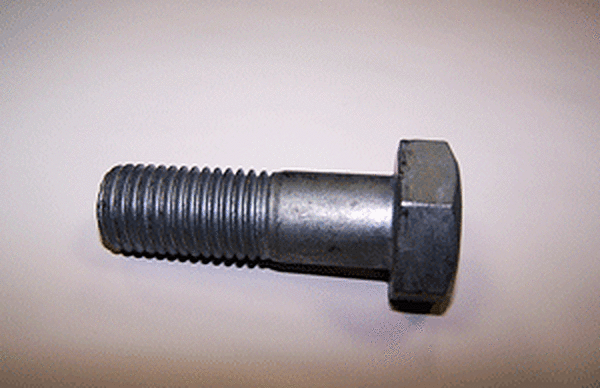Threaded Assemblies

Best design practice for corrosion protection suggests to avoid dissimilar metals in contact whenever possible. Zinc, used to coat hot-dip galvanized fasteners, sacrifices itself to protect nearly every other metal, diminishing its longevity. Therefore, to enhance corrosion protection, hot-dip galvanized fasteners are recommended for galvanized structural assemblies.
Best practice also recommends studs and bolted assemblies be sent to the galvanizer disassembled. Masking to prevent galvanizing threads on pipe or fittings is very difficult. The recommended practice is to clean and tap after galvanizing. Anchoring devices (such as threaded rods and anchor bolts) sometimes are specified to be galvanized in the threaded areas only or in the areas to be exposed above ground. This can be more expensive than galvanizing the complete unit because of the additional handling required. Complete galvanizing can be specified for items to be anchored in concrete.

Manufacturers of threaded parts recognize special procedures must be followed in their plants when certain items are to be galvanized. Following are some examples:
- Low carbon bars are recommended since high carbon or high silicon cause a heavier, rougher galvanized coating on the threads.
- Hot-formed heading or bending requires cleaning at the manufacturing plant to remove scale before threading. Otherwise, over-chemical cleaning of threads will result during scale removal.
- Sharp manufacturing tools are mandatory. Ragged and torn threads open up in the chemical cleaning and galvanizing processes. Worn tools also increase bolt diameters. Frequent checking is necessary on long runs.
- Standard sized threads are cut on the bolt, while standard sized nuts are retapped oversize after galvanizing.
The table below shows the recommended overtapping for nuts and interior threads as detailed in ASTM A563, Specification for Carbon and Alloy Steel Nuts. On threads over 1.5 inches (38 mm) it is often more practical, if design strength allows, to have the male thread cut 0.031" (0.8 mm) undersize before galvanizing so a standard tap can be used on the nut.
Overtapping Guidelines for Nuts and Interior Threads
| Nominal Nut Size (inches) and Pitch | Diametrical Allowance (inches) |
|---|---|
| 0.250-20 | 0.016 |
| 0.312-18 | 0.017 |
| 0.375-16 | 0.017 |
| 0.437-14 | 0.018 |
| 0.500-13 | 0.018 |
| 0.562-12 | 0.020 |
| 0.625-11 | 0.020 |
| 0.750-10 | 0.022 |
| 0.875-9 | 0.022 |
| 1.000-8 | 0.024 |
| 1.125-8 | 0.024 |
| 1.125-7 | 0.024 |
| 1.250-8 | 0.024 |
| 1.250-7 | 0.024 |
| 1.375-8 | 0.027 |
| 1.375-6 | 0.027 |
| 1.500-8 | 0.027 |
| 1.500-6 | 0.027 |
| 1.750-5 | 0.050 |
| 2.000-4.5 | 0.050 |
| 2.250-4.5 | 0.050 |
| 2.500-4.5 | 0.050 |
| 2.750-4 | 0.050 |
| 3.000-4 | 0.050 |
| 3.250-4 | 0.050 |
| 3.500-4 | 0.050 |
| 3.750-4 | 0.050 |
| 3.750-4 | 0.050 |
| 4.000-4 | 0.050 |
| For metric overtapping allowances, see ASTM A 563M, section 7. | |
